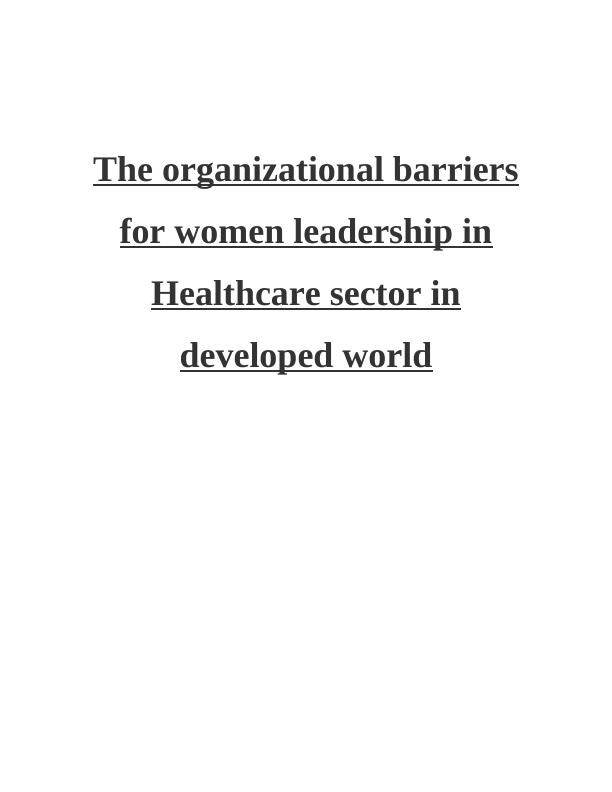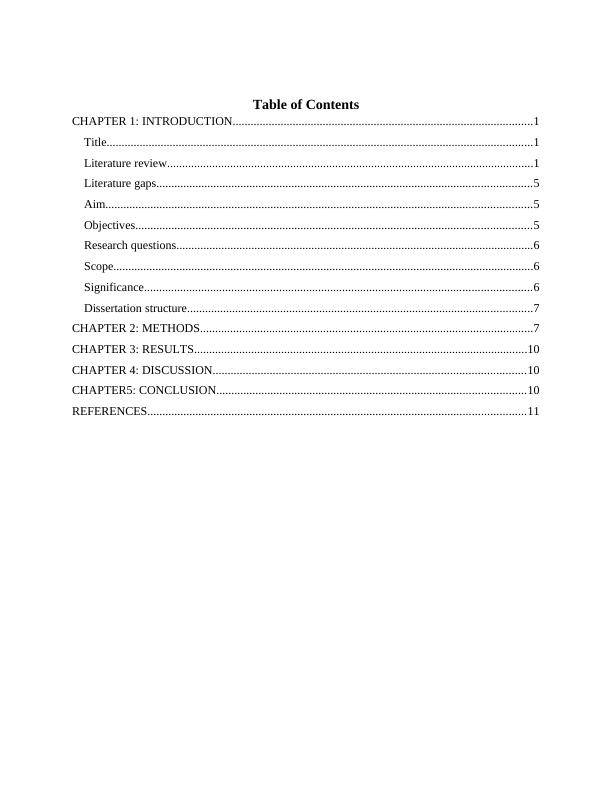Organisational barriers for women leadership in healthcare sector in developed world
Added on 2023-01-16
14 Pages4896 Words81 Views
The organizational barriers
for women leadership in
Healthcare sector in
developed world
for women leadership in
Healthcare sector in
developed world

Table of Contents
CHAPTER 1: INTRODUCTION....................................................................................................1
Title..............................................................................................................................................1
Literature review..........................................................................................................................1
Literature gaps.............................................................................................................................5
Aim..............................................................................................................................................5
Objectives....................................................................................................................................5
Research questions.......................................................................................................................6
Scope............................................................................................................................................6
Significance.................................................................................................................................6
Dissertation structure...................................................................................................................7
CHAPTER 2: METHODS...............................................................................................................7
CHAPTER 3: RESULTS...............................................................................................................10
CHAPTER 4: DISCUSSION........................................................................................................10
CHAPTER5: CONCLUSION.......................................................................................................10
REFERENCES..............................................................................................................................11
CHAPTER 1: INTRODUCTION....................................................................................................1
Title..............................................................................................................................................1
Literature review..........................................................................................................................1
Literature gaps.............................................................................................................................5
Aim..............................................................................................................................................5
Objectives....................................................................................................................................5
Research questions.......................................................................................................................6
Scope............................................................................................................................................6
Significance.................................................................................................................................6
Dissertation structure...................................................................................................................7
CHAPTER 2: METHODS...............................................................................................................7
CHAPTER 3: RESULTS...............................................................................................................10
CHAPTER 4: DISCUSSION........................................................................................................10
CHAPTER5: CONCLUSION.......................................................................................................10
REFERENCES..............................................................................................................................11

CHAPTER 1: INTRODUCTION
Title
“Organisational barriers for women leadership in healthcare sector in developed
world”.
Participation of women is increasing various segments particularly in health care sector but they
are often under represented in leadership roles. As per the statistics of world health organisation,
nearly 70% of the healthcare workforce comprise of women (Women in the health workforce,
2018). According to the statistics given in briefing paper “Women and the economy” by Powell,
2019 (Accessed through link:
https://researchbriefings.parliament.uk/ResearchBriefing/Summary/SN06838) women
employment rate in UK is 71.4% in 2018 while that of males was 80.3%. The maximum
percentage of jobs held by women in UK were also in health care sector.
Despite such huge engagement in the industry the women faces a wide range of barriers
and challenges in organisation affecting their performance and limiting their ability and growth
opportunities. Women leaders face more organisational barriers as compare to men leaders on
the basis of gender stereotypes related to women (Kalaitzi and et.al., 2017). This gender
discrimination affects performance of individuals and deprive highly talented leaders in
exploring growth opportunities. Such organisational barriers not only prevent talented health care
force from providing good quality services but are also crucial in affecting the service quality
and requirements of the community (Wahid and et.al., 2017). In addition to the women
empowerment encouraging equal opportunities for women leaders is also vital for the improved
health care services and needs.
Literature review
Women work force in healthcare
According to Carmona, (2017) women are equal part of the health care but their gender
aspect make their path to leadership more challenging. There are several stereotypes which
demands that women must act in appropriate ways and they must act ideally in accordance with
the cultural needs. The stereotypes and theories about women leaders are quite rampant and also
make it challenging for them to provide best of the their professional role due to restrictions
imposed by social and cultural gender stereotypes. Women leaders are often discouraged and
deprived of leadership opportunities as it is assumed that women cannot be good leaders
1
Title
“Organisational barriers for women leadership in healthcare sector in developed
world”.
Participation of women is increasing various segments particularly in health care sector but they
are often under represented in leadership roles. As per the statistics of world health organisation,
nearly 70% of the healthcare workforce comprise of women (Women in the health workforce,
2018). According to the statistics given in briefing paper “Women and the economy” by Powell,
2019 (Accessed through link:
https://researchbriefings.parliament.uk/ResearchBriefing/Summary/SN06838) women
employment rate in UK is 71.4% in 2018 while that of males was 80.3%. The maximum
percentage of jobs held by women in UK were also in health care sector.
Despite such huge engagement in the industry the women faces a wide range of barriers
and challenges in organisation affecting their performance and limiting their ability and growth
opportunities. Women leaders face more organisational barriers as compare to men leaders on
the basis of gender stereotypes related to women (Kalaitzi and et.al., 2017). This gender
discrimination affects performance of individuals and deprive highly talented leaders in
exploring growth opportunities. Such organisational barriers not only prevent talented health care
force from providing good quality services but are also crucial in affecting the service quality
and requirements of the community (Wahid and et.al., 2017). In addition to the women
empowerment encouraging equal opportunities for women leaders is also vital for the improved
health care services and needs.
Literature review
Women work force in healthcare
According to Carmona, (2017) women are equal part of the health care but their gender
aspect make their path to leadership more challenging. There are several stereotypes which
demands that women must act in appropriate ways and they must act ideally in accordance with
the cultural needs. The stereotypes and theories about women leaders are quite rampant and also
make it challenging for them to provide best of the their professional role due to restrictions
imposed by social and cultural gender stereotypes. Women leaders are often discouraged and
deprived of leadership opportunities as it is assumed that women cannot be good leaders
1

especially in health care systems which demands for complex timings and hectic work schedules.
According to What About Women in the Workplace in Scandinavia? (2018), data provided by the
percentage of female workforce in Norway and Sweden is nearly 48% while for Denmark is
47%. In the same context Haile, Emmanuel and Dzathor, (2016) stated that existing stereotypes
and lack of support from the staff members also diminishes the confidence level of women
employees. Thus as a result both men and women employees in health care assume and accept
that men leaders are more efficient and suitable for the health care industry. The women are also
liable and expected to fulfil their household responsibilities as the primary duty. Thus even if
they are in role of leadership then also it is believed that they must not compromise towards their
family and household responsibility. Hence the over expectation from them leads to professional
and personal imbalance affecting the confidence level of women. In the same wake people also
used to withdraw their support and cooperation from women leaders to challenge them and to
prove that since they have family responsibilities they cannot become a good leader.
As per the view of Makarem, (2016) the perception that motherhood is critical aspect of
only one gender and thus it is impossible for women to balance motherhood and their long term
professional plans. Thus women leaders may have expertise and efficiency but they cannot serve
organisation for long term as man leader. Hence most of the health care service providers used to
prefer men leaders so that long term support can be expected.
Connerley and Wu, (2016) elucidated that there is lack of gender equality in existing
social system. Even in developed countries women does not have equal treatment or
opportunities. The industries such as health care sector which have good participation of women
employees also used to have great extent of boundaries for the roles and responsibilities of
women leaders. In the male dominating societies it is still a very challenging aspect to accept the
women leaders, managing and leading a team comprising of all male members. This is one of the
reason that most of the women who have leadership capabilities does not take initiatives to
overcome organisational challenges. Women leaders believe that it can be hard for the other
members to accept their leadership and thus it will influence the team outcomes and will even
raise a question on their efficiency.
Organisational barriers related to women leadership
According to Choi and et.al., (2016) in addition to the social inequalities in gender there
are several aspects or organisational factors which act as barrier to leadership of women leaders.
2
According to What About Women in the Workplace in Scandinavia? (2018), data provided by the
percentage of female workforce in Norway and Sweden is nearly 48% while for Denmark is
47%. In the same context Haile, Emmanuel and Dzathor, (2016) stated that existing stereotypes
and lack of support from the staff members also diminishes the confidence level of women
employees. Thus as a result both men and women employees in health care assume and accept
that men leaders are more efficient and suitable for the health care industry. The women are also
liable and expected to fulfil their household responsibilities as the primary duty. Thus even if
they are in role of leadership then also it is believed that they must not compromise towards their
family and household responsibility. Hence the over expectation from them leads to professional
and personal imbalance affecting the confidence level of women. In the same wake people also
used to withdraw their support and cooperation from women leaders to challenge them and to
prove that since they have family responsibilities they cannot become a good leader.
As per the view of Makarem, (2016) the perception that motherhood is critical aspect of
only one gender and thus it is impossible for women to balance motherhood and their long term
professional plans. Thus women leaders may have expertise and efficiency but they cannot serve
organisation for long term as man leader. Hence most of the health care service providers used to
prefer men leaders so that long term support can be expected.
Connerley and Wu, (2016) elucidated that there is lack of gender equality in existing
social system. Even in developed countries women does not have equal treatment or
opportunities. The industries such as health care sector which have good participation of women
employees also used to have great extent of boundaries for the roles and responsibilities of
women leaders. In the male dominating societies it is still a very challenging aspect to accept the
women leaders, managing and leading a team comprising of all male members. This is one of the
reason that most of the women who have leadership capabilities does not take initiatives to
overcome organisational challenges. Women leaders believe that it can be hard for the other
members to accept their leadership and thus it will influence the team outcomes and will even
raise a question on their efficiency.
Organisational barriers related to women leadership
According to Choi and et.al., (2016) in addition to the social inequalities in gender there
are several aspects or organisational factors which act as barrier to leadership of women leaders.
2

End of preview
Want to access all the pages? Upload your documents or become a member.
Related Documents
Impact of Gender Diversity in Leadership within Healthcarelg...
|9
|2600
|95
Culture, Power and Identity in Tourism, Hospitality and Eventslg...
|14
|3609
|265
Managing a Workforcelg...
|4
|685
|53
Women in Leadership Rolelg...
|12
|3193
|461
International Relations and Security Studies - Assignmentlg...
|15
|3334
|201
Ageism and the Common Good in Healthcarelg...
|5
|1096
|42
